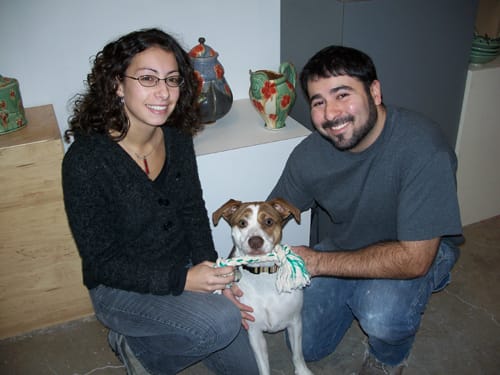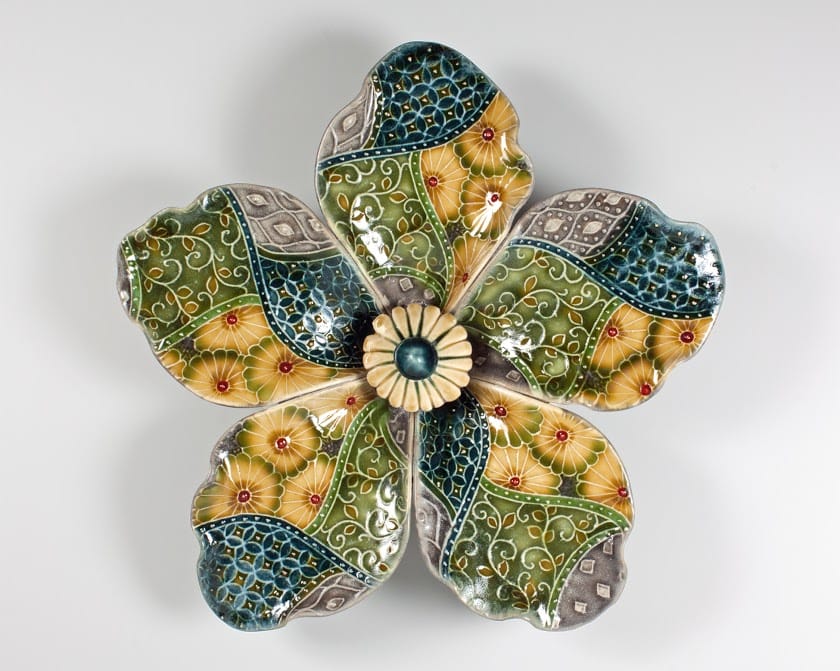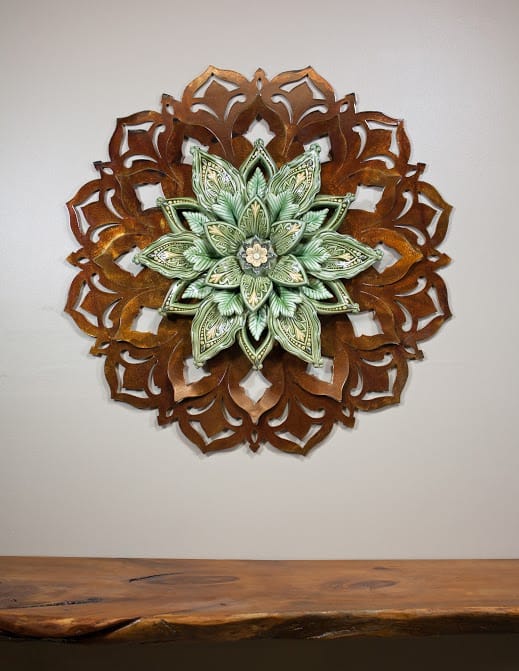Ceramic art is one love that has bonded Adam and Sarah Spector together. Adam and Sarah, the artists at Spector Studios in the Finger Lakes region of New York state, love to take old ideas—Oribe ceramics from Japan, British Arts and Crafts Period textiles and handmade tiles from many regions—and thoughtfully reinterpret them. They did this with different lines of functional pottery they’ve created over the past fifteen years, and more recently with the large decorative ceramic art pieces they are now producing.
Welum caught up with the couple at the beginning of the hectic arts and crafts show season to discuss how their work has evolved, from where they derive their inspiration and what it is like to combine work, marriage and life with two rescued dogs in a creative studio.
1) How did you get started?
Adam: I started studying ceramic art in a private studio and in my high school's clay program early on. I knew pretty early that I wanted to do ceramics professionally. My parents were supportive and let me make a big clay mess in the downstairs storage room. The summer of
my junior year of high school I did the summer program at the New York State College for Ceramics at Alfred University. I then applied early decision to Alfred and completed a BFA with a concentration in Ceramics.
Sarah: Growing up, I always thought I would be involved in an art field in some way. In high school I fell in love with clay and continued my studies at Alfred University, also getting my BFA with a concentration in Ceramics. I didn't think I would ever be a self-employed artist even after graduating (my dad is self employed and I saw how hard he works!). Adam showed me it was possible and eventually convinced me with his unending optimism.
2) From where do you derive inspiration?
We are both interested in historical ceramic art and other historical craft media (textiles, handmade tile, architectural ornament). We are inspired by patterns from Oribe Japanese ceramics, Morris wallpaper designs from the Arts & Crafts period. We also love to
explore nature...wildflowers, a stand of birch trees.
3) What's the favorite piece of ceramic art you've each designed?
Usually our favorite pieces are the newest pieces. They hold the most mystery and potential.
4) What are the pros and cons of being an artist couple who lives
and works together?
Sarah: We enjoy working together and do it pretty well most days! Our strengths compliment each other. Adam is great at coming up with new ideas, implementing them and I am good at hashing out the details of a project. It's great to have another person to brainstorm with. Separating work and home time can be difficult but communication is key to letting the other know if you're okay to talk about a to do list or a technical question while you are weeding outside or in the shower. We've learned to read each other pretty well. That said, arguments happen especially when you are making most decisions jointly. Moving on quickly and inserting humor are important.
5) Are there any kinds of art or hobbies that you pursue
individually?
Sarah: We both enjoy hiking and trail running. We love eating all different kinds of food. Adam has been playing guitar since he was young and recently has been learning in the Flamenco tradition. I enjoy yoga and meditation.
6) I know there's a short description of the process by which you
make your ceramic art on your website but could you please explain the process in a little bit more detail? Is every piece hand carved or crafted?
Sarah: We've made many different bodies of work over the past fifteen years, allowing us to explore many different technical processes. It's interesting how one body of work informs the next. The current work consists of pieces for the wall. Hand-built flowers are made from
flat sheets of clay called slabs and assembled while the porcelain is still wet. We'll often emboss the surface of each flower petal with patterns that we've hand carved.
After a piece comes out of the kiln for the first time (bisque) we decorate it using bottles filled with our glazes that we've formulated (this process is called glaze trailing). We'll then brush
on a liquid wax over the trailed accent colors and finally dip the piece in the main glaze color. The wax burns off in the next and final kiln firing and what remains is multiple side-by-side glaze colors.
Sometimes we include steel elements to accent the porcelain sculptures. Usually I draw the outline for the piece and Adam texture grinds and patinas it.
7) What is your favorite part of the process?
Adam: Making new work is my favorite part. I love experimenting with new techniques and processes. I revel in a good challenge both technically and artistically. Outside of studio work I’ve recently gotten excited about posting our process and finished pieces to Instagram (@spectorstudiosporcelain). It’s interesting to engage with artists and creative people all over the world—I had to learn what a hashtag was and learned the “Translate” comment feature is great!
Sarah: I love making the centers of the flowers and carving new patterns. I also like the technical challenge of figuring out how different parts can go together. And of course opening a glaze kiln full of pieces makes me a little giddy!
8) From where is your furthest away customer? What's your most
memorable sale?
Sarah: Every so often a piece will come out that you feel a strong connection to. When that piece goes home with someone that you can tell has an equally strong connection to your creation, it is magic.
9) You do a lot of shows. What do you like (and dislike) about the
art fair circuit? Do your dogs always go with you?
Sarah: Our dogs are Chloe, a ten-year-old Beagle/Lab mix and Dexter, a Boston Terrier/Chihuahua mix. Both are rescues so breed specifics are always up for debate! Dexter we actually got while at a show in Alabama. But the dogs almost never get to come with us.
Doing juried art fairs gives us the freedom to follow our creative inclinations without many restrictions. People approach us to do interesting projects that lead us down new paths like our large-scale steel and porcelain flowering tree branch sculptures for the wall. We get
the opportunity to interact with people and experience in person their reactions to new ideas and work. It also can be anxiety producing with so many variables affecting a successful show, the weather, other events going on, the news, booth location, show advertising. A lot of time and energy goes into applying to shows, packing, booth display and setup, traveling...I also get separation anxiety leaving our dogs at home with our house sitter. They're fine; I just hate leaving their furry little faces!
Overall, doing shows is important because it forces us to put on real clothes rather than our usual pajama inspired studio attire.



